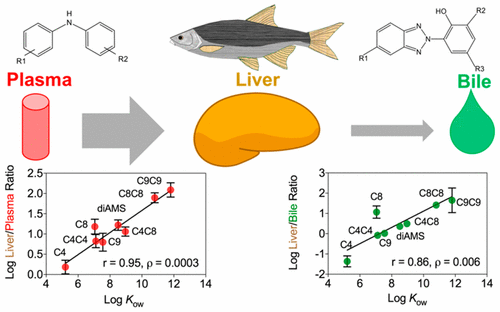当前位置:
X-MOL 学术
›
Environ. Sci. Technol. Lett.
›
论文详情
Our official English website, www.x-mol.net, welcomes your feedback! (Note: you will need to create a separate account there.)
Tissue Distribution of Substituted Diphenylamine Antioxidants and Benzotriazole Ultraviolet Stabilizers in White Sucker (Catostomus commersonii) from an Urban Creek in Canada
Environmental Science & Technology Letters ( IF 10.9 ) Pub Date : 2017-09-11 00:00:00 , DOI: 10.1021/acs.estlett.7b00355 Zhe Lu 1 , Amila O. De Silva 1 , Thomas E. Peart 1 , Cyril J. Cook 1 , Gerald R. Tetreault 1
Environmental Science & Technology Letters ( IF 10.9 ) Pub Date : 2017-09-11 00:00:00 , DOI: 10.1021/acs.estlett.7b00355 Zhe Lu 1 , Amila O. De Silva 1 , Thomas E. Peart 1 , Cyril J. Cook 1 , Gerald R. Tetreault 1
Affiliation

|
Substituted diphenylamine antioxidants (SDPAs) and benzotriazole ultraviolet stabilizers (BZT-UVs) have been detected in aquatic organisms, but little is known about their tissue distribution and elimination in wildlife. This study investigates the distribution of SDPAs and BZT-UVs in blood plasma, bile, liver, and carcass (without gill and internal organs) of white sucker (Catostomus commersonii) and evaluates the extent of biliary excretion in fish. Fish were collected from a creek upstream and downstream of an urban area in Ontario, Canada. Downstream fish showed levels of contamination of many target compounds [e.g., 4,4′-bis(α,α-dimethylbenzyl)diphenylamine and monononyl-diphenylamine] higher than those of upstream fish, indicating the input of these contaminants from the urban area. The concentration (wet weight) of target compounds generally decreased in the following order: liver > carcass homogenate ≥ bile > plasma. This indicates that liver is a major tissue for accumulation of these contaminants in fish. Tissue-specific partition coefficients suggest that SDPAs tend to partition from plasma to liver and that the biliary excretion of these contaminants is a relatively minor pathway of elimination. Only monobutyl-diphenylamine was effectively excreted via bile. Our results suggest that future studies should focus on the liver toxicities and biotransformation of these contaminants to improve our understanding of their environmental risks.
中文翻译:

来自加拿大城市溪的白色吸盘(Catostomus commersonii)中取代的二苯胺抗氧化剂和苯并三唑紫外线稳定剂的组织分布
在水生生物中已检测到取代的二苯胺抗氧化剂(SDPAs)和苯并三唑紫外线稳定剂(BZT-UVs),但对于它们在野生生物中的组织分布和消除知之甚少。这项研究调查了SDPAs和BZT-UVs在白色吸盘(Catostomus commersonii)的血浆,胆汁,肝脏和car体(无g和内脏)中的分布),并评估鱼中胆汁排泄的程度。鱼是从加拿大安大略省市区上游和下游的一条小溪中采集的。下游鱼类显示出许多目标化合物[例如4,4'-双(α,α-二甲基苄基)二苯胺和单壬基-二苯胺]的污染水平高于上游鱼类,表明这些污染物来自市区。目标化合物的浓度(湿重)通常按以下顺序降低:肝脏> cas体匀浆≥胆汁>血浆。这表明肝脏是鱼类中这些污染物积累的主要组织。组织特异性的分配系数表明,SDPAs倾向于从血浆向肝脏分配,这些污染物的胆汁排泄是相对较小的清除途径。仅单丁基-二苯胺可通过胆汁有效排泄。我们的结果表明,未来的研究应集中于这些污染物的肝毒性和生物转化,以增进我们对它们的环境风险的了解。
更新日期:2017-09-12
中文翻译:

来自加拿大城市溪的白色吸盘(Catostomus commersonii)中取代的二苯胺抗氧化剂和苯并三唑紫外线稳定剂的组织分布
在水生生物中已检测到取代的二苯胺抗氧化剂(SDPAs)和苯并三唑紫外线稳定剂(BZT-UVs),但对于它们在野生生物中的组织分布和消除知之甚少。这项研究调查了SDPAs和BZT-UVs在白色吸盘(Catostomus commersonii)的血浆,胆汁,肝脏和car体(无g和内脏)中的分布),并评估鱼中胆汁排泄的程度。鱼是从加拿大安大略省市区上游和下游的一条小溪中采集的。下游鱼类显示出许多目标化合物[例如4,4'-双(α,α-二甲基苄基)二苯胺和单壬基-二苯胺]的污染水平高于上游鱼类,表明这些污染物来自市区。目标化合物的浓度(湿重)通常按以下顺序降低:肝脏> cas体匀浆≥胆汁>血浆。这表明肝脏是鱼类中这些污染物积累的主要组织。组织特异性的分配系数表明,SDPAs倾向于从血浆向肝脏分配,这些污染物的胆汁排泄是相对较小的清除途径。仅单丁基-二苯胺可通过胆汁有效排泄。我们的结果表明,未来的研究应集中于这些污染物的肝毒性和生物转化,以增进我们对它们的环境风险的了解。



























 京公网安备 11010802027423号
京公网安备 11010802027423号